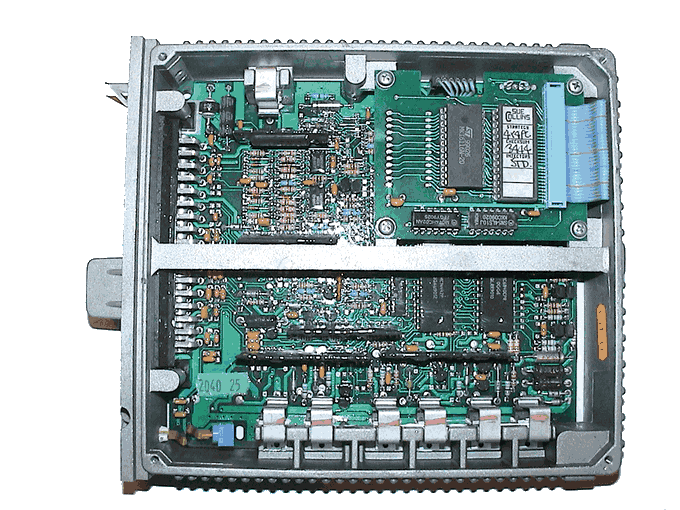Pectel Board
The Level 8 ecu came with a baby board screwed onto lugs above the main board which added extra RAM along with relocating the EPROM onto it. The L1 and L6 ecus were able to manage with the 192 bytes built into the 6803U4 microprocessor, but the extra inputs on the L8 required more variables to be stored and so a 2K RAM was added, which was more than adequate. The two logic chips are used to map the RAM into memory at 1800h-1FFFh and a space is also left for another RAM or ROM at 1000h-17FFh.(Whether the chips are read only or read /write is determined by the two links at the top right). Fitting an I/O or Timer chip here would provide extra inputs or outputs i.e. a 74LS244 octal buffer/latch would provide 8 extra data lines for controlling things like water injection, cooling fan, nitrous, injectors.... There is also no reason why a board like this could not be adapted to work with the L1 / L6 to increase its memory capacity to that of a L8.
The board has two connectors - one plugs into the standard EPROM socket (using the lower 24 pins of the 28 pin socket) and the other a connector for extra lines required for address decoding.
The Pectel board is a 3rd party supplied board which adds extra functionality to the standard L8 program like serial communications and sometimes extras such as water injection, air injector control and 12 position selectable boost.
The board can be identified by 'PECTEL' etched into it at the top left, along with the issue number, and the white labels on the small address decoding chips. Instead of the basic logic chips used on the standard baby board, these are programmable logic array chips which also decode the data lines of the program from the EPROM which is stored in an encoded form to prevent copying. The only reason for needing a Pectel board is when running an encrypted Pectel EPROM as it is basically not doing anything which cannot be done with the standard baby board.
The Pectel software enables the connection of a Pectel monitor which displays data from the ecu on a LCD screen. The data is the actual values used by the ecu in its calculations so it is very accurate.
The rotary switch changes the data which is displayed from the following parameters:
RPM, ACT, MAP, ECT, TPS, Injector period, Ignition timing, CO pot position, Battery volts, Engine run time, Data logging.
The data is transferred by using the standard diagnostics in / out lines on pins 8 & 27 of the ecu but, instead of a slow flash code, the serial port of the micro has been enabled in software (no modifications are required to the ecu). The software has an interrupt routine added which works in the background and waits for a data byte(s) defining which value is required and it then replies with the corresponding real time value. Using a suitable interface circuit, a PC can be connected to the ecu using its serial com port and then it is possible to directly read any data value required or even take control of the injection time / ignition advance.
There was another board available called the Pectel Super 8 which had the ability to run an 8 injector engine (2 per cylinder). The 4 extra power transistors can be seen screwed to the central strut of the ecu, with the injector loom going out on the far left.
